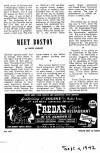
Home Page Meet Boston Menu Index
|
MEET BOSTON Friday, September 4, 1942 in What's New In Town W. J. Sidis |
The corner of Summer and Washington Streets is now considered the most central point in Boston, but it was not always so. Even in Civil War days, it was at best a neighborhood shopping center. The stationing of soldiers on the Common during the Civil War led to extensive patronizing of shops in the Winter Street region, and the growth of establishments in that area. The little Gilchrist “general store” had to enlarge, while others in the region shared in the general boom of that part of town. The Great Fire of 1872, which burned out most of downtown Boston, brought more benefit than injury to this area. Gilchrist’s was undamaged, as was Jordan’s, a little way southward; but older shopping areas were hopelessly wiped out, so that shoppers coming in town were practically forced to use the Winter Street neighborhood, which became the city’s main center from then on. Gilchrist’s still occupies its original corner; diagonally across is Jordan’s, now extended from its old location all the way to Summer Street. A third corner at that crossing is occupied by the Filene store, which has the distinction of containing the world’s first automatic bargain basement―the one from which all others are copied. While the fourth corner is the former Filene store―where it was before present building was put up.
*
One curious feature to be found occasionally with Boston streets is the arms on some streets―branches which are considered part of the same street. The best known of these is the arm of Mason Street that reaches to Tremont Street. It was originally part of Avery Street before that passageway was straightened out. There is also such an arm on Battery-march Street, connecting with Broad Street. Numerous other cases can be found in the suburbs. The type of phenomenon is almost unknown in other cities.
*
The hottest day on record was July 4, 1911, when the official temperature reached 104. On Washington Street, in front of Thompson’s Spa, the thermometer registered 116. But such is the remarkable resiliency of New England weather that within two hours the temperature had dropped to 60. Our good old East Wind came to the rescue.
*
Recently, in an article on the come-back of the horse in Boston, we mentioned a national magazine printing a photo of horse cabs waiting for passengers at Trinity Place Station, and asked the readers what was wrong with the picture. Did you guess that one? It should be obvious. Trinity Place Station is exclusively for outbound trains.
*
Trinity Church was on the site of Filene’s before the Great Fire of 1872. Its ruins stood out after the Fire among the leveled remains of the burned district.